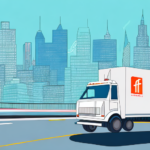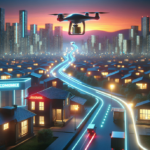Last Mile Delivery Ecommerce Shipping Solutions: Optimizing Your Delivery Process
In ecommerce, the last mile delivery process is crucial for ensuring customer satisfaction and building brand loyalty. Essentially, it refers to the final stage of the process where the package is delivered to the customer's doorstep. Despite being the last and most important aspect of the entire supply chain, this stage often poses the biggest challenge in ecommerce shipping. However, with the help of advanced technology and strategic planning, it is possible to optimize your delivery process and ensure a seamless customer experience. In this article, we will explore the importance of last mile delivery in ecommerce shipping, the challenges faced during this process, the role of technology in optimizing last mile delivery, and strategies for improving last mile delivery performance.
The Importance of Last Mile Delivery in Ecommerce Shipping
Customers today expect fast and reliable delivery, and this expectation has been heightened since the COVID-19 pandemic. A delay or mishap in the final stage of shipping can lead to customer dissatisfaction, negative reviews, and damage to your brand reputation. On the other hand, a smooth and efficient last mile delivery process can enhance customer satisfaction and build loyalty. According to a Statista report, over 50% of consumers consider fast delivery as a critical factor in their purchasing decisions.
- Enhanced Customer Satisfaction: Reliable delivery builds trust and encourages repeat purchases.
- Brand Loyalty: Positive delivery experiences foster long-term customer relationships.
- Competitive Advantage: Efficient last mile delivery can differentiate your business from competitors.
Challenges in the Last Mile Delivery Process
Last mile delivery involves several logistical challenges that can impact performance:
- Address Errors: Incorrect or incomplete addresses can lead to delivery delays.
- Traffic Congestion: Heavy traffic can increase delivery times and fuel costs.
- Inaccessible Delivery Locations: Remote or hard-to-reach areas pose significant delivery challenges.
- Theft or Damage: Packages are susceptible to theft or damage during transit.
- Limited Delivery Options: Limited flexibility in delivery times and locations can reduce customer satisfaction.
These challenges can lead to increased operational costs and decreased efficiency, but there are solutions to mitigate these issues.
Technological Innovations in Last Mile Delivery
Technology plays a crucial role in optimizing the last mile delivery process. Key technological advancements include:
- GPS Tracking and Route Mapping: Provides real-time visibility and allows for on-the-go adjustments.
- Delivery Scheduling Software: Helps in efficient planning and execution of delivery routes.
- Robotic Delivery Methods and Drones: Offer innovative solutions, especially in areas where traditional methods are less effective.
- Automated Customer Service: Chatbots and automated systems provide instant assistance, addressing customer concerns promptly.
According to a Forbes article, the implementation of AI and machine learning in route planning can reduce delivery times by up to 30%.
Strategies for Optimizing Last Mile Delivery Performance
To enhance last mile delivery performance, consider the following strategies:
1. Identifying and Addressing Inefficiencies
Conduct regular audits and analyze data to pinpoint areas needing improvement. For instance, addressing high rates of delivery failures can significantly reduce costs.
2. Investing in Delivery Infrastructure
Establishing micro-fulfillment centers and local warehouses can help reduce delivery times and operational costs. A McKinsey report suggests that localized fulfillment can enhance delivery efficiency.
3. Collaborating with Local Partners
Partnering with local couriers or delivery startups can expand delivery reach and provide more delivery options for customers.
4. Offering Flexible Delivery Options
Providing alternative delivery options, such as locker pickups or delivery to nearby stores, allows customers to choose the most convenient method for them.
Enhancing Customer Satisfaction through Efficient Last Mile Delivery
The key to enhancing customer satisfaction lies in providing timely and reliable service:
- Transparent Communication: Keep customers informed about delivery timelines and any potential delays.
- Multiple Delivery Options: Offer choices such as standard, same-day, or next-day delivery to cater to diverse customer preferences.
- Real-Time Tracking: Implement real-time tracking and notifications to keep customers updated on their delivery status.
- Responsive Customer Service: Address customer feedback and resolve issues promptly to maintain trust and satisfaction.
Sustainable and Eco-Friendly Approaches to Last Mile Delivery
Sustainability is becoming increasingly important in last mile delivery operations. Companies are adopting green practices to reduce their environmental impact:
- Electric Vehicles: Utilizing electric vehicles for deliveries to minimize emissions.
- Bike Couriers and On-Foot Deliveries: Deploying alternative transportation methods in urban areas.
- Biodegradable Packaging: Using environmentally friendly packaging materials to reduce waste.
- Incentivizing Sustainable Choices: Encouraging customers to opt for eco-friendly delivery options.
According to the United Nations Sustainable Development Goals, sustainable delivery practices contribute to reducing overall carbon emissions and promoting environmental responsibility.
Measuring and Improving Last Mile Delivery Performance
Tracking and analyzing key metrics are essential for measuring the success of last mile delivery:
- Delivery Times: Monitor average delivery times to ensure timely fulfillment.
- Order Accuracy: Track the accuracy of orders to reduce returns and increase customer satisfaction.
- Delivery Costs: Analyze costs associated with deliveries to identify areas for cost reduction.
- Customer Satisfaction Rates: Use surveys and feedback to gauge customer satisfaction.
- Return Rates: Monitor return rates to understand and address potential issues in the delivery process.
By regularly monitoring these metrics, businesses can identify areas for improvement, track progress towards goals, and optimize their last mile delivery process effectively.
Future Trends and Sustainability in Last Mile Delivery
The future of last mile delivery in the ecommerce industry is poised for continued innovation and advancements:
- Automation and Robotics: Increased use of automated systems and robotics to streamline delivery operations.
- AI and Machine Learning: Enhancing route optimization and predictive analytics to anticipate customer needs.
- Sustainable Delivery Practices: Emphasizing eco-friendly delivery options to reduce the carbon footprint.
- Advanced Data Analytics: Leveraging data to gain deeper insights and make informed decisions.
As reported by Business Insider, the integration of AI and sustainable practices will be pivotal in shaping the future of last mile delivery.
Avoiding Common Mistakes in Last Mile Delivery Strategy
To ensure an effective last mile delivery strategy, businesses should avoid common pitfalls:
- Poor Planning: Inadequate planning can lead to inefficiencies and increased costs.
- Inadequate Communication: Lack of transparent communication with customers can result in dissatisfaction.
- Over-Reliance on Third-Party Partners: Depending too heavily on external partners may compromise service quality.
- Lack of Flexibility: Inability to adapt to changing customer preferences and market conditions can hinder performance.
- Failure to Monitor Performance: Not regularly assessing performance metrics can prevent timely identification of issues.
By addressing these areas, businesses can develop a more robust and efficient last mile delivery process.
Conclusion
Optimizing last mile delivery in ecommerce shipping remains a critical component of building a successful and sustainable business. By prioritizing customer satisfaction, investing in technology and infrastructure, and adhering to sustainable and regulatory standards, businesses can create an efficient supply chain that meets the evolving needs of today's consumers. Embracing these strategies and continuously adapting to industry trends will ensure long-term success and customer loyalty.






















